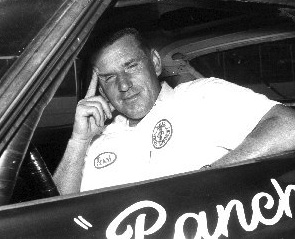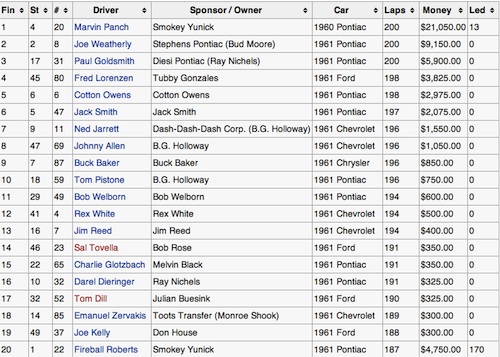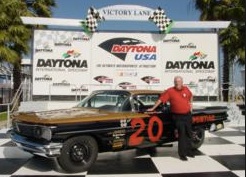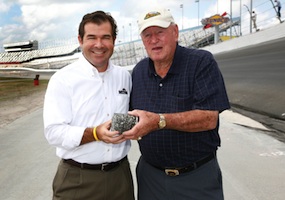

Pettys fly over wall in preliminary races; Arizona driver killed in practice

 Video by NASCARAllOut / Use by Headline Surfer® / Pontiac was the dominant car for the 1961 running of the Daytona 500, and Marvin Panch who didn't even have a ride for the season, won the race as a last-minute driver behind the wheel of a year-old Pontiac for race car owner Smokey Yunick on the recommendation of fellow driver Fireball Roberts, who had the pole and led the most laps before blowing an engine in the closing laps.
Video by NASCARAllOut / Use by Headline Surfer® / Pontiac was the dominant car for the 1961 running of the Daytona 500, and Marvin Panch who didn't even have a ride for the season, won the race as a last-minute driver behind the wheel of a year-old Pontiac for race car owner Smokey Yunick on the recommendation of fellow driver Fireball Roberts, who had the pole and led the most laps before blowing an engine in the closing laps.DAYTONA BEACH -- Fireball Roberts led the most laps -- 170 -- but with 13 laps to go, the pole sitter blew an engine and the lead to the driver who didn't even have a ride until the eve of Speedweeks in Marvin Panch who would stay out front and win the 1961 Daytona 500.
It was Roberts in the No. 22 Pontiac who suggested car owner Smokey Yunick give Panch a start in one of his cars.
Ironically, the 1960 Pontiac that Panch took the checkered flag in, was the same car Roberts had driven in the previous Daytona 500.
Caution-free Daytona 500 far cry from earlier Speedweeks crashes
The caution-free Daytona 500 race was like night-and-day compared to the tragedy-marred Speedweeks at Daytona.
It was the first Daytona 500 run without a single caution flag, though two drivers were black-flagged earlier in the race for driving too slow.
Tensions were high going into the signature race with several horrific crashes and a fatal wreck in practice.
In the first of two qualifying races, Richard Petty flew out of the track wall and ended up with shards of glass in his eyes, that required treatment in the infield care center.
His father, Lee Pretty, winner of the first Daytona 500 in 1959, went over the wall, along with Johnny Beauchamp. The elder Petty's racing career was over with the serious injuries that required he be hospitalized for four months.
Harold Haberling lost his life while practicing in a 1955 Chevrolet in preparation for the 250-mile support race for the Daytona 500. The driver from Phoenix, Ariz., crashed in turn 3, causing his car to roll over on the 31-degree banking, killing him.
Haberling's death was the first fatality on the 2.5-mile super speedway since 1959.
Lee Petty and Johnny Beauchamp fly over the outside wall and out of Daytona International Speedway during a prelimininary qualifying race for the 1961 Daytona 500.
Tensions were high going into the signature race with several horrific crashes and a fatal wreck in practice. In the first of two qualifying races, Richard Petty flew out of the track wall and ended up with shards of glass in his eyes, that required treatment in the infield care center. His father, Lee Pretty, winner of the first Daytona 500 in 1959, went over the wall, along with Johnny Beauchamp.
The elder Petty's racing career was over with the serious injuries that required he be hospitalized for four months.
Harold Haberling lost his life while practicing in a 1955 Chevrolet in preparation for the 250-mile support race for the Daytona 500. The driver from Phoenix, Ariz., crashed in turn 3, causing his car to roll over on the 31-degree banking, killing him. Haberling's death was the first fatality on the 2.5-mile super speedway since 1959.
Panch was not even scheduled to drive in the big race.
That is, until Roberts approached his team owner,Yunick, and suggested he give Panch a ride, which he subsequently did in the No. 20, a year-old Pontiac, the same car Roberts drove in the 1960 Daytona 500. Roberts drover a 1961 Pontiac wide track.
 Panch, who started fourth, drove the No. 20 to victory in three hours and 20 minutes, after Roberts blew an engine with just 13 laps to go, as the upstart Panch took the lead and never relinquished it, with Joe Weatherly, who started the race out front with Robverts, on his rear-end.
Panch, who started fourth, drove the No. 20 to victory in three hours and 20 minutes, after Roberts blew an engine with just 13 laps to go, as the upstart Panch took the lead and never relinquished it, with Joe Weatherly, who started the race out front with Robverts, on his rear-end.
Ironically, Roberts finished the race in 20th place, the same number as the car Panch drove to victory.
Weatherly, finished in second where he started. And Paul Goldsmith, who started 17th, finished the race in third place.
Panch, Weatherly and Goldsmith, all driving Pontiacs, were the only drivers to complete all 200 laps.
Other notable drivers were Ned Jarrett who finished seventh, David Pearson came in 21st, Bobby Allison in 31st, Buddy Baker 40th and Junior Johnson, 44th.
Panch completed the 500 miles with only one change of tires, and in a then-record for a 500 mile closed-course race of any kind. Having completed the race in 3 hours, 20 minutes, and 32 seconds, the time equated to an average speed of 149.601 mph.
Back then, Daytona International Speedway didn't have a designated Victory Lane, so Punch parked his winning Pontiac in the infield grass, and celebrated win with track owner Bill France Sr., along with Yunick and his family members.
Back then, Daytona International Speedway didn't have a designated Victory Lane, so Punch parked his winning Pontiac in the infield grass, and celebrated win with track owner Bill France Sr., along with Yunick and his family members.
Racing Notes:
FAST FACTS: Marvin Panch, 1961 Daytona 500 winner
 Photo for Headline Surfer® / Marvin Panch is shown a few years ago at Daytona International Speedway with a replica of the No. 20 Pontiac he took the checkered flag in to win the 1961 Daytona 500 with pole sitter Fireball Roberts, who led most of the laps, blowing an engine and setting the stage for Panch's historic win at Daytona. Incredibly, he won despite having only gone through onlyone tire change as there were no caution flags and few opportunities to gwt into the pits.
Photo for Headline Surfer® / Marvin Panch is shown a few years ago at Daytona International Speedway with a replica of the No. 20 Pontiac he took the checkered flag in to win the 1961 Daytona 500 with pole sitter Fireball Roberts, who led most of the laps, blowing an engine and setting the stage for Panch's historic win at Daytona. Incredibly, he won despite having only gone through onlyone tire change as there were no caution flags and few opportunities to gwt into the pits.Did You Know?
 Photo for Headline Surfer® /
Photo for Headline Surfer® / 